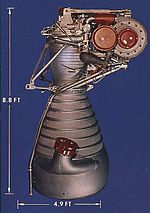H-1 (rocket engine)

A cluster of 8 H-1 rocket engines lifted the Saturn I from the launch pad.
|
|
| Country of origin | United States |
|---|---|
| Date | 1963-1975 |
| Manufacturer | Rocketdyne |
| Application | Booster |
| Successor | RS-27 |
| Status | Retired |
| Liquid-fuel engine | |
| Propellant | LOX / RP-1 |
| Cycle | Gas Generator |
| Configuration | |
| Chamber | 1 |
| Performance | |
| Thrust (SL) | 205,000 lbf (900 kN) |
| Thrust-to-weight ratio | 102.47 |
| Chamber pressure | 700 psia (4.8 MPa) |
| Isp (vac.) | 289 seconds (2.83 km/s) |
| Isp (SL) | 255 seconds (2.50 km/s) |
| Burn time | 155 s |
| Dimensions | |
| Length | 8.8 feet |
| Diameter | 4.9 feet |
| Dry weight | 2,200 lb (1,000 kg) |
| Used in | |
| Saturn I, Saturn 1B | |
The Rocketdyne H-1 is a 205,000 lbf (910 kN) thrust liquid-propellant rocket engine burning LOX and RP-1. The H-1 was developed for use in the S-I and S-IB first stages of the Saturn I and Saturn IB rockets, respectively, where it was used in clusters of eight engines. After the Apollo program, surplus H-1 engines were rebranded and reworked as the Rocketdyne RS-27 engine with first usage on the Delta 2000 series in 1974.
The H-1 is one of a series of engines developed from the wartime V-2 ballistic missile. During the war, North American Aviation (NAA) was given several 59,600 lbf (264.9 kN) V-2 engines to examine and convert from metric to SAE measurements. They formed their "Propulsion Division" to handle this work, later becoming Rocketdyne.
NAA had also been given a wealth of technical documentation on the engine, where engineers came across plans to improve the V-2 engine using a new fuel injector. The Germans were unable to get the design to work, however, and it never went into service. NAA engineers decided to attack this problem, and quickly came up with solutions. This allowed them to raise the thrust of the design to 75,000 lbf (330 kN), and then 78,000 lbf (350 kN) for the Redstone missile.
NAA had also been working on the SM-64 Navaho cruise missile project, which used the same engine as a booster to get the missile up to speed so its ramjet engines could light. The Air Force continually demanded higher performance from the Navaho, which forced NAA to build larger aircraft, and larger boosters to launch it. By the early 1950s, the basic engine design had been enlarged to produce 120,000 lbf (530 kN).
All of these designs, like the V-2 that spawned them, burned alcohol, but other fuels had also been experimented with, including kerosene, diesel oil, paint thinner, JP-4, and JP-5 jet fuel. In January 1953 Rockedyne started their "REAP" program to convert these engines to a specific and well engineered kerosene fuel specifically for rocket engines, which became RP-1, officially specified in Military Specification MIL-R-25576 in 1954.
...
Wikipedia
